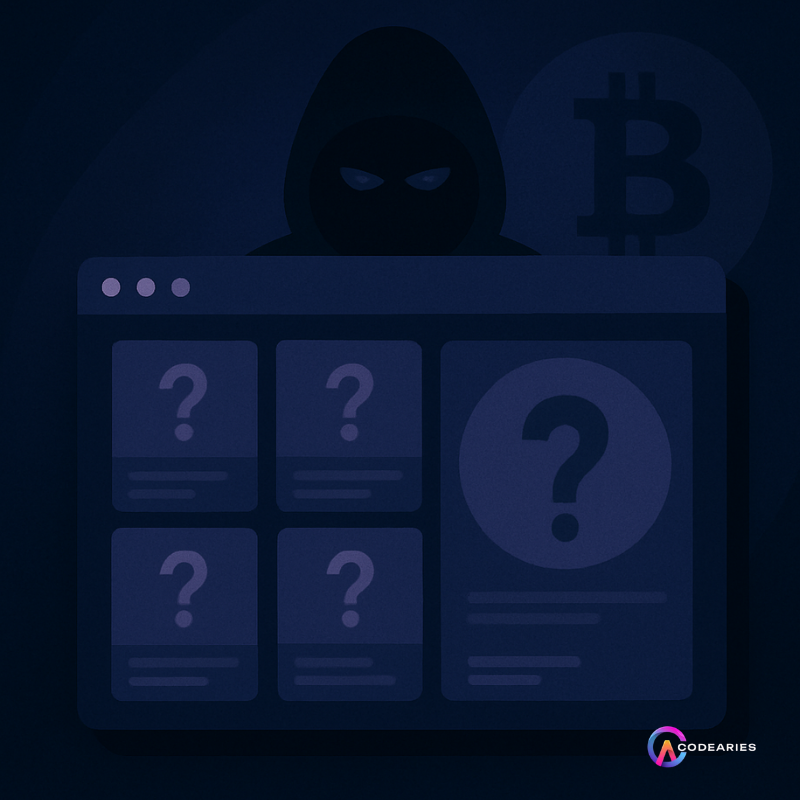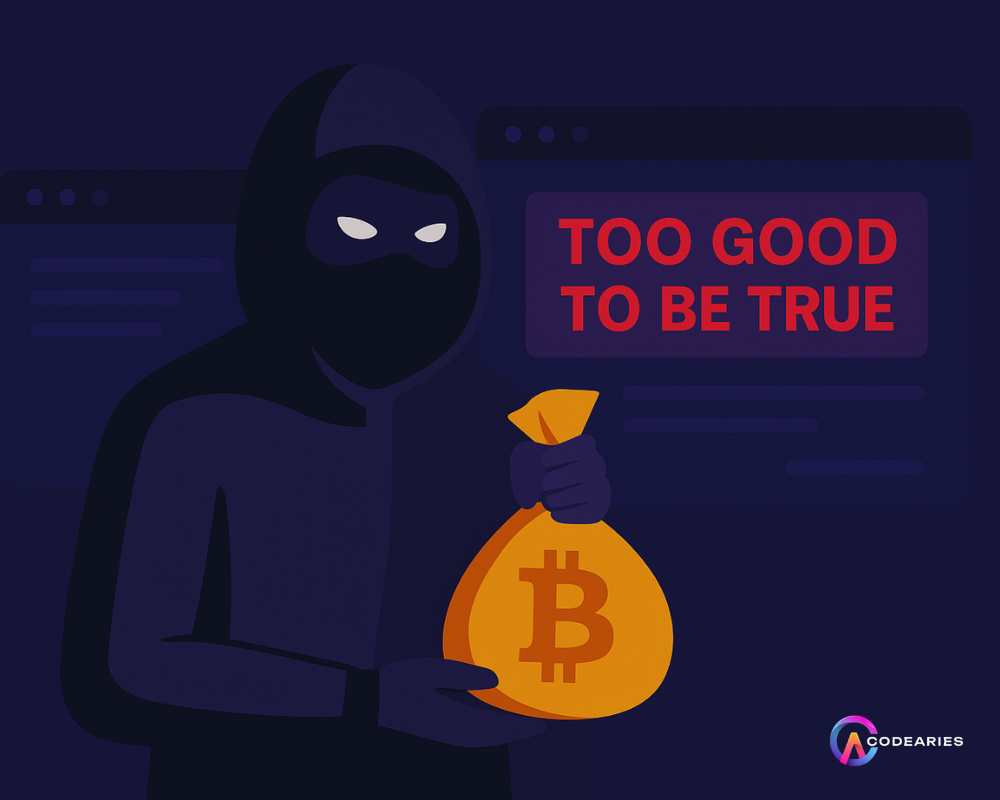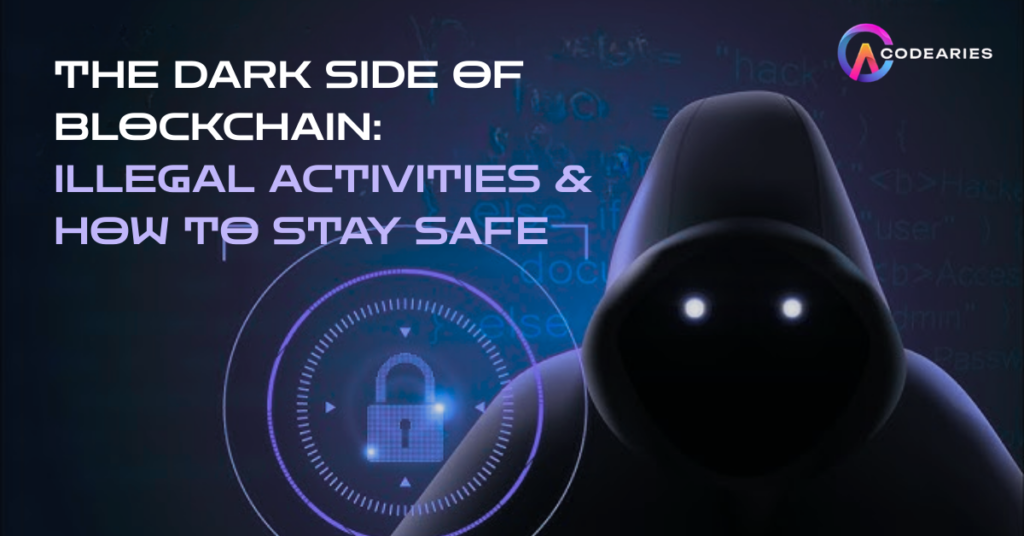Blockchain technology has transformed industries by providing transparency, decentralization, and security. However, it is also susceptible to misuse. Blockchain and cryptocurrencies have become tools for various illegal activities, including money laundering, fraud, ransomware, and illegal marketplaces. As the blockchain ecosystem grows, it is crucial to understand the risks and learn how to protect yourself.
In this blog, we explore the darker side of blockchain, identify the types of illegal activities enabled by crypto, and offer practical tips for staying safe. Additionally, discover how Codearies assists businesses in developing secure and compliant blockchain solutions.

The Spectrum of Illegal Activities in Blockchain
1. Money Laundering and Terrorism Financing
The pseudonymous nature of blockchain attracts launderers looking to hide the origins of illicit funds. Criminals convert dirty money into cryptocurrencies and use decentralized exchanges or tumblers (mixers) to anonymize transactions. They then convert the crypto back into fiat currency, often crossing borders. Recent reports indicate that billions of dollars flow through illicit crypto addresses each year. For example, platforms like Garantex have faced fines for facilitating funds linked to ransomware groups and other criminal networks. Various groups also use digital assets to finance terrorism, taking advantage of the challenges in tracking these transactions.
2. Fraud and Scams
From Ponzi schemes to fake ICOs, blockchain has become a haven for fraudsters. High-profile cases like BitConnect, OneCoin, and Centra led to millions—sometimes billions—of dollars being stolen or lost due to false promises and manipulation. Complex scams such as “pig butchering” and phishing are constantly evolving, targeting inexperienced users. Criminal marketplaces like Huione Guarantee allow the sale of hacking tools and fake verification services.
3. Ransomware and Extortion
Malicious actors demand crypto payments to unlock encrypted data or stop attacks. The inability to reverse and the quick nature of crypto transactions make ransom payments effective and hard to track. Ransomware groups like Conti, LockBit, and NetWalker have channeled millions through crypto exchanges despite sanctions and enforcement efforts.
4. Darknet Markets and Illegal Goods
Blockchain has played a significant role in supporting darknet markets like the infamous Silk Road. Digital currencies facilitate transactions related to drugs, weapons, illegal wildlife trade, counterfeit documents, and materials for child exploitation. With varying levels of security and anonymity, criminals trust cryptocurrency as a means to hide their tracks.
5. Market Manipulation and Insider Trading
Manipulative tactics like wash trading, spoofing, and pump-and-dump schemes can skew prices and mislead investors on crypto exchanges. While regulatory bodies are increasing their enforcement efforts globally, there are still gaps in regulation.

How to Stay Safe in the Blockchain World
1. Use Reputable Platforms
Stick to well-known, regulated exchanges and wallets with strong security measures.
2. Follow Security Best Practices
Utilize hardware wallets for large amounts, enable multi-factor authentication (MFA), avoid sharing private keys or seed phrases, and be cautious of phishing attempts.
3. Conduct Due Diligence
Before investing or interacting with new projects, thoroughly evaluate the team, technology, tokenomics, and community. Watch out for exaggerated claims or guaranteed returns.
4. Leverage Blockchain Analytics
Organizations and informed users can use tools like Chainalysis, Elliptic, or CipherTrace to track suspicious transactions and verify counterparties’ legitimacy.
5. Stay Educated
Cybercriminals are always finding new ways to cheat. Stay updated on emerging tactics like deepfakes, social engineering, and phishing campaigns.
6. Work with Trusted Partners
Collaborate with blockchain development experts who emphasize security, compliance, and transparency throughout the technology lifecycle.
The Role of Regulation and Enforcement in 2025
Regulators worldwide are stepping up:
- Significant actions against fraudulent exchanges, layering services, and unlicensed operators.
- Enhanced focus on KYC/AML policies in crypto platforms.
- Collaboration across borders to trace and seize illicit crypto proceeds.
- Legislative clarity on asset definitions, tax compliance, and data protection.
How Codearies Helps Businesses Secure Blockchain Projects
At Codearies, we understand that trust and security are essential for successful blockchain adoption. Our clients, ranging from fintech startups to large enterprises, rely on us to design, develop, and protect their blockchain systems.
Our comprehensive approach includes:
- End-to-End Security Audits
We conduct thorough reviews and tests of smart contracts, dApps, wallets, and infrastructure to find and fix vulnerabilities. - Compliance Integration
We implement KYC and AML modules, regulatory reporting, and audit-ready trails that follow global standards. - Risk Mitigation Frameworks
Our services include real-time monitoring, anomaly detection, and fraud prevention tailored to the specific threats facing your platform. - Incident Response & Crisis Management
We have practiced protocols and rapid response capabilities to minimize damage from security events. - User Security Education and Tools
We develop user-friendly, secure interfaces and educate users on phishing, scams, and protective measures.
Ultimately, our goal at Codearies is to create blockchain systems that foster innovation while ensuring resilience, transparency, and user safety.
Frequently Asked Questions
How does Codearies ensure security in blockchain projects?
We combine top audits, ongoing monitoring, and secure design principles so we can address and minimize vulnerabilities before they become problems.
Can Codearies help with regulatory compliance related to blockchain and crypto?
Yes, we implement KYC and AML modules, ensure compliance with GDPR, and keep updated on local and international regulatory changes.
What are the common types of crypto-related fraud we should watch for?
It’s essential to recognize phishing, rug pulls, Ponzi schemes, wash trading, and unauthorized access attempts. Codearies builds defenses to protect against these threats.
Does Codearies provide post-launch security support?
Definitely, We maintain continuous monitoring through analytics, threat detection, incident response, and patching to keep your platform secure over time.
How can users protect themselves from crypto scams?
Use hardware wallets, enable MFA, never share sensitive information, verify all communications, and avoid offers that seem too good to be true. Codearies helps brands educate their users on staying safe.







